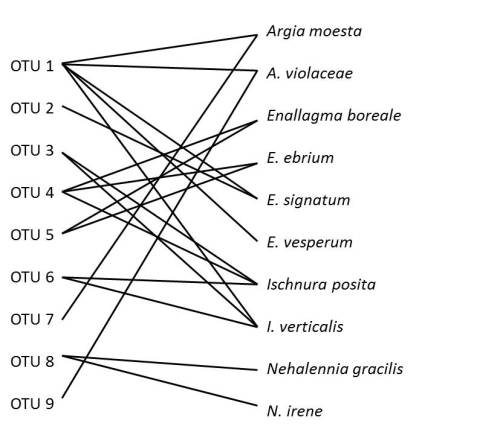(I must first apologize for not posting anything sooner, but I have been very busy working on my thesis and manuscripts. I know it’s not an excuse but it’s the only one I have. So the following is one of the reasons why I haven’t posted earlier.)
The third of five data chapter of my thesis has been published in BMC Ecology with Wayne Knee and Mark Forbes as my co-authors (Mlynarek et al 2013).
This paper answers the question: does host geographic range explain measures of parasitism in the damselfly-water mite (external parasites) system (Fig 1). The answer can be found in the title: “Relative geographic range of sibling species of host damselflies does not reliably predict differential parasitism by water mites”.

Figure 1 A super infected Enallagma erbium damselfly. The red dots on the thorax and abdomen are the water mites
This paper/chapter is a continuation of the previous paper/data chapter where I tested the same question with gregarine parasites (internal parasites) in damselflies (Mlynarek et al 2012). Although in that paper, host geographic distribution actually explained the variation in gregarine parasitism at least half of the time. One of the main conclusions that can be made comparing these two projects is that different types of parasites (internal versus external) even in the same host species are explained by different factors.
So why don’t I say a little more about this most recent paper. Based on Mlynarek et al (2012) I expected similar results, the species with bigger geographic distribution will have higher numbers of parasites, but this did not happen. In this paper, I looked at 10 species grouped in 5 species pairs based on taxonomic classification. The results really surprised me, in only two of the five species pairs there was significant or near significant difference in the proportion of individuals parasitized between the species (Fig 2).

Difference in prevalence of water mite parasitism, the * indicates species pairs that showed significant differences in parsaitism
And in one of the two species pairs, it was the species with the smaller geographic distribution that had more parasites. As for intensity, or the average number of parasites individuals the infected host individuals have, only one of the species showed significant difference and again it was the less widespread species that had more parasites (Fig 3).

Difference in intensity of water mite parasitism, the * indicates species pairs that showed significant differences in parsaitism
But we went a step further with this study and identified the water mites molecularly using the DNA barcode, cytochrome oxidase 1 (CO1) to see if we can get a handle about host ranges, or how many host species a water mite species can successfully infect. Based on our molecular analysis, we collected 9 Operational taxonomic units (or OTUs). Most of the mites OTUs seem to be generalist in that they infect more than one host species, but there are two specialists (Fig 4). You can see in figure that it’s pretty messy although there are tendencies for more closely related host species to be infected by the same water mite OTUs.
This made me realize that closely related species actually seem to have similar levels of parasitism. But it still makes me wonder whether there are host characteristics actually explain the variation in parasitism we see between host species at a broader taxonomic scale; that is yet another chapter of my thesis which I’m working on now.
References
Mlynarek, J.J., Hassall, C. and M.R. Forbes. 2012. Higher gregarine parasitism often in sibling species of host damselflies with smaller geographic distributions. Ecological Entomology 37: 419-425.
Mlynarek, J.J, Knee, W. and M.R. Forbes. 2013. Relative geographic range of sibling species of host damselflies does not reliably predict differential parasitism by water mites. BMC Ecology 13:50, doi:10.1186/1472-6785-13-50.

